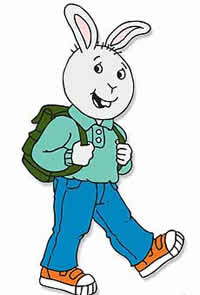Play
 Some people talk about play as if it were a relief from serious learning; but, for children, play is serious business. Some people talk about play as if it were a relief from serious learning; but, for children, play is serious business.
It provides a way for them to express strong feelings about important events in their lives. Play gives children a chance to work out problems on their own, to cope with anxieties, and to prepare for life as an adult by pretending about being grown up.
Through play, children discover the world and learn more about themselves. -- Fred Rogers
|
|
Map It!
from "It's a Big Big World"
 Maps are small representations of the real world and can help us picture the location of a place such as a country, determine the distance between two places such as our hometown and the capital city, or select the best route to take to a destination such as the lake. Maps are small representations of the real world and can help us picture the location of a place such as a country, determine the distance between two places such as our hometown and the capital city, or select the best route to take to a destination such as the lake.
Related Episodes: Map It Out (on NHPTV June 6 and 8 at 8:30 a.m.)
Ages: 5-6
Subject: Geography
Skills: Observation, Critical Thinking, Identification, Planning
Materials: Paper, crayons/markers/colored pencils
Directions: Ask your child if she can think of a time when your family has used a map to get information about a place. Perhaps you were at the mall and wanted to find a particular store, or you were going to a new friend's house and you needed to know what streets to walk on, or you were planning a trip and needed to know how long it would take to travel there. Maps can help us in all of these situations by telling us where things are in a particular location, how to get from one place to another, and how far apart two things are.
Tell her that she is going to create a map of her own. Together, select and go to a location that she is familiar with and has a few obvious landmarks, for example, a room in your home, a yard or park, or the street in front of your home. Let her observe the location for a few minutes and then ask her what objects she is going to include in her map. Once she had determined those, have her draw her map.
Talk About It : Look at her map together and talk about how it could be useful for someone who has never been to the area before. What objects does it show? Could she use it to give directions to someone? For example, if her map is of a park, does it show how many trees are located in one area? Or does it show that there is a set of swings to the left of the path?
Take It Further: Ask your child if she could visit anywhere in the world, where would it be. Then, using maps on the Internet or at the library, determine how far away that place is from where you live. Compare that distance to a shorter distance that she travels frequently. For example, if it is 300 miles from your home to her chosen destination, you may tell her that her school is about three miles away, so you would have to travel from your home to school 100 times to go that many miles. Or, if it takes her about 20 minutes to walk one mile from your home to a local park, it would take her 300 hours (or 12 1/2 full days!) to walk there.
|